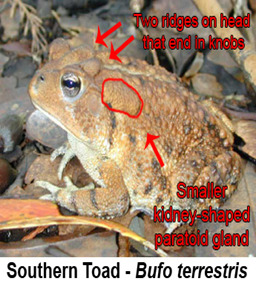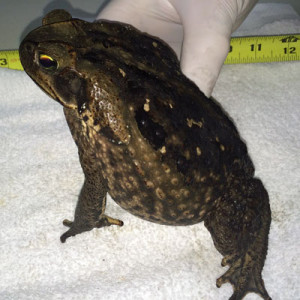Beware of the Toxic Bufo (Giant) Toad
The toxic bufo toad (Bufo marinus) (AKA marine toad, giant toad, cane toad) is not your average toad. Its venom can be deadly to any pet that gets the toxin in its mouth and/or swallows it. It is a huge brown to grayish-brown toad with a creamy yellow belly and deeply pitted parotid glands extending down the back. Adult giant toads generally range in size from 4 to 6 inches but may be as large as 9 inches. They are non-native and are replacing the smaller nontoxic native Southern toad (Bufo terrestris) in the cities of southern Florida.
The giant toad was introduced in 1936 when the Agricultural Experimental Station of the University of Florida imported 200 from Puerto Rico and released them at Canal Point and Belle Glade in Palm Beach County to control sugar cane pests. The current South Florida population of toxic toads resulted from an accidental release of about 100 specimens from the stock of a pet dealer at Miami airport in 1955 and subsequent releases by pet dealers in the 1960s. It is a relatively long-lived toad reaching ages of 10 to 15 years.
The native nontoxic southern toad (Bufo terrestris) is often mistaken for the toxic giant toad (Bufo marinus). Here are a few ways to distinguish between the nontoxic Bufo terrestris (southern toad) and the toxic Bufo marinus (giant toad):
The southern toad has smaller kidney-shaped parotid glands that secrete a substance which may be irritating to mucous membranes but is not toxic. The giant toad has very large parotid glands that secrete a toxic substance.
- The southern toad has two highly pronounced knobs and crests (ridges) that occur on its head. The overall coloring of this toad varies from brown, black, or red. It has no dark spots and only one or two warts. The giant toad does not have knobs or crests on its head and has dark spots and many warts.
- The adult southern toad ranges in length from 1.75 to 4.5 inches. The adult giant toad ranges in length from 4 to 6 inches.
- The adult southern toad ranges in length from 1.75 to 4.5 inches. The adult giant toad ranges in length from 4 to 6 inches.

Nontoxic Southern Toad

Toxic Giant Toad
The toxic bufo toad sits in an upright position when it moves, and it hops in short fast hops. When confronted by a predator, it is able to “shoot” bufo toxin from the parotid and other glands on its back in the form of white viscous venom. The secretions are highly toxic to dogs, cats, and other animals and can cause skin irritation in humans. These marine toads are most frequently seen under the streetlights of the suburbs. Interestingly, opossums are immune to its venom.
To avoid attracting toads, do not leave pet food outside in open dishes. Bufos are also attracted to water bowls and may sit in the rim long enough to leave sufficient toxin to make a pet ill. Another way to reduce the number of toads in your yard is to add an 18” high chicken wire fence (with small holes) to the bottom of your existing fencing. Bufo toads cannot jump higher than 15”, and adults cannot fit through the small holes. If a dog “mouths” the toxic giant toad, he/she can receive a large dose of the bufo’s toxins secreted from its skin and parotid glands. Symptoms generally include profuse foamy salivation that looks like shaving cream, difficulty breathing, brick red gums, convulsions, paralysis, ventricular fibrillation, vomiting, and uncoordinated staggering. If untreated, there is close to a 100% death rate from Bufo marinus toxicity.
Keeping your dog on a leash and well supervised outdoors should be sufficient to prevent bufo toad contamination. Carry a flashlight at night to check out anything your dog may be overly curious about. These toads don’t attack, but a curious dog sniffing or licking the toad can be poisoned. South Florida pet emergency clinics see about six cases monthly and many more during the rainy season.
Bufo toads (the term is redundant as bufo is Latin for toad) are seen mostly during the rainy season (late May to mid October) and most often at night near well lit areas because bugs are attracted to light and toads are attracted to bugs, their primary food source. They are infrequently during daylight hours but can be found hiding under vegetation.
IF YOUR PET SHOWS BUFO TOAD TOXICITY SYMPTOMS immediately rinse out the pet’s mouth with a dripping wet wash cloth several times to remove any toxin from the mouth, pointing the pet’s head downward to avoid the toxin being swallowed. Do not use a hose to rinse the mouth as water can easily be forced into the lungs causing more problems. Proceed to the nearest veterinary clinic or emergency clinic because time is of the essence. The smaller the pet or the larger the toad, the greater risk of toxicity. The death rate for untreated animals affected by Bufo marinus toxin may approach 100%.
HUMANELY ELIMINATE any giant toad you find by rubbing or spraying 20% benzocaine toothache gel or sunburn spray (not 5% lidocaine) on the toad’s lower belly; in a few minutes, it will become unconscious. Then put the toad in a sealed plastic bag in the freezer for 24 to 48 hours to ensure that it is humanely euthanized before disposal. These toads are a non-native species and are not protected.
Credits
Photos were supplied by Barry Mansell Photos to the University of Florida, Florida Wildlife Extension Service. website http://www.wec.ufl.edu/extension/
www.fondrenpetcare.com
WEC-11, one of a series of the Wildlife Ecology and Conservation department, Florida Cooperative Extension Service, Institute of Food and Agricultural Sciences, University of Florida. Published: June 1990. Reviewed: September 2002.
USGS/Florida Integrated Science Center
[email protected]
Poisoned! John Cargill & Susan Thorpe-Varg
Attention Pet Owners: Beware of Bufo Toads
Bufo Toads in South Florida: a Threat to Your Pet by Dr. Mary C. Fondren www.fondrenpetcare.com
Description
 The bufo toad (Bufo marinus) (also known as marine toad , giant toad, cane toad) is a huge brown to grayish-brown toad with a creamy yellow belly and deeply-pitted parotoid glands extending down the back (1). Adult giant toads generally range in size from 6 to 9 in (15 to 23 cm) but may get larger ( 1). They are replacing the native southern toad (Bufo terrestris) in the cities of southern Florida (2).
The bufo toad (Bufo marinus) (also known as marine toad , giant toad, cane toad) is a huge brown to grayish-brown toad with a creamy yellow belly and deeply-pitted parotoid glands extending down the back (1). Adult giant toads generally range in size from 6 to 9 in (15 to 23 cm) but may get larger ( 1). They are replacing the native southern toad (Bufo terrestris) in the cities of southern Florida (2).
The first attempted introduction of this toad was in 1936 when the Agricultural Experimental Station of the University of Florida imported 200 marine toads from Puerto Rico and released them at Canal Point and Belle Glade in Palm Beach County Florida to control sugar cane pests (2). The current population was released before May 1955 near Miami airport (2). It is a relatively long-lived toad reaching ages up to 10 years (3).
The bufo toad sits in an upright position when it moves and hops in short fast hops (3). When confronted by a predator, it is able to “shoot” bufo toxin from the parotoid and other glands on the back in the form of white viscous venom (3). These secretions are highly toxic to dogs, cats, and other animals and can cause skin irritation in humans (1). These marine toads are most frequently seen under the street lights of the suburbs (2).
To avoid attracting toads to areas where pets are, do not leave pet food in open dishes in the yard. Bufos are attracted to watering dishes and may sit in the rim long enough to leave enough toxin to make a dog ill. Dogs that mouth bufo toads can get a large dose of the bufo’s toxins, secreted from the skin and parotoid glands. Symptoms generally include profuse foamy salivation that looks like shaving cream, difficulty breathing, brick red gums, convulsions, paralysis, ventricular fibrillation, vomiting, and uncoordinated staggering. Untreated, the pet death rate from Bufo marinus poisoning may approach 100% (4).
Keeping your dog on a leash and well supervised when outdoors should be sufficient to prevent bufo toad toxicity. We suggest you carry a flashlight at night, so that if the dog seems overly curious about something you can check it out. These toads don’t actually attack, but a curious dog sniffing or licking the toad can get poisoned as a result.
Bufo toads (actually that’s redundant as bufo is latin for toad) are seen mostly during the rainy season (late May to mid October) and most often at night near lighted areas as they are attracted by the bugs. They are seen much less frequently during daylight hours but can be found hiding under vegetation. One of the ways to reduce toads in your yard is to eliminate potential food sources. Leaving uneaten pet food or water bowls out in the yard can attract toads.
At Fondren Pet Care Center we see only a few cases of bufo toad toxicity each year. By educating our clients about the potential hazards we’ve reduced the incidence of encounters with toads. The Pet Emergency Clinic sees about a half dozen cases monthly with higher rates during the rainy season.
First Aid
Immediately rinse out the pet’s mouth with a drippy wet wash cloth several times to remove any toxin from the mouth. Do not use a hose to rinse the mouth as water can easily be forced into the lungs causing more problems. Proceed to the nearest veterinary clinic or emergency clinic as time is of the essence. The smaller the pet or the larger the toad, the greater there is a risk of toxicity. Do not attempt to treat this at home. Untreated, the death rate for Bufo marinus might approach 100%
Control
These toads are a non-native species and are not protected. They can be removed and disposed of humanely by placing them in a plastic container (or bag) in the freezer for three days and then burying the carcasses. If you do not wish to handle the toads, contact a local nuisance animal trapper (4).
The native Southern Toad (Bufo terrestris) is sometimes mistaken for the Giant Toad. Here are a few ways to tell these toads apart: While the Giant (Bufo) Toad has very large parotid glands, the Southern Toad has smaller kidney-shaped parotoid glands, which secrete a substance that may be irritating to mucous membranes but is not toxic. The Southern Toad has two ridges on its head that end in knobs. The Giant Toad does not have these. The adult Southern Toad ranges in length from 1.75 to 4.5 inches. The adult Giant Toad ranges in length from 4 – 6 inches.
Credits
Photos provided by: University of Florida, Florida Wildlife Extension Service web site http://www.wec.ufl.edu/extension/
(1). This document is WEC-11, one of a series of the Wildlife Ecology and Conservation department, Florida Cooperative Extension Service, Institute of Food and Agricultural Sciences, University of Florida. Published: June, 1990. Reviewed: September, 2002.
(2). McCann Book Chapter 7, [email protected]
(3). Bufo Marinas Cane toad, Giant Toad written by Ryan Hilgris, Michigan State University student
(4). Poisoned!, John Cargill & Susan Thorpe-Varg

